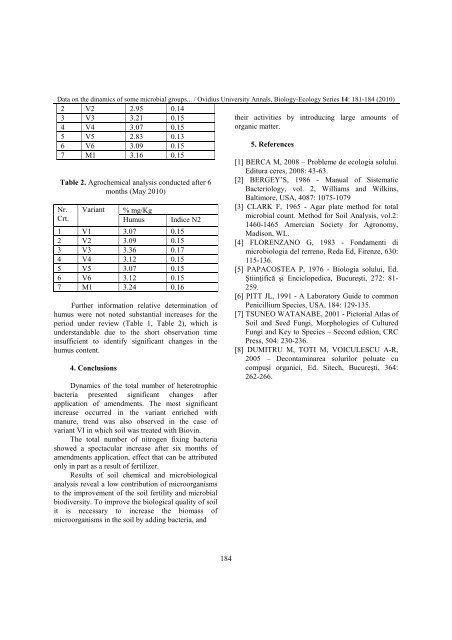VOLUM OMAGIAL - Facultatea de Ştiinţe ale Naturii şi Ştiinţe Agricole
VOLUM OMAGIAL - Facultatea de Ştiinţe ale Naturii şi Ştiinţe Agricole
VOLUM OMAGIAL - Facultatea de Ştiinţe ale Naturii şi Ştiinţe Agricole
You also want an ePaper? Increase the reach of your titles
YUMPU automatically turns print PDFs into web optimized ePapers that Google loves.
Data on the dinamics of some microbial groups... / Ovidius University Annals, Biology-Ecology Series 14: 181-184 (2010)<br />
2 V2 2.95 0.14<br />
3 V3 3.21 0.15<br />
4 V4 3.07 0.15<br />
5 V5 2.83 0.13<br />
6 V6 3.09 0.15<br />
7 M1 3.16 0.15<br />
Table 2. Agrochemical analysis conducted after 6<br />
months (May 2010)<br />
Nr.<br />
Crt.<br />
Variant % mg/Kg<br />
Humus Indice N2<br />
1 V1 3.07 0.15<br />
2 V2 3.09 0.15<br />
3 V3 3.36 0.17<br />
4 V4 3.12 0.15<br />
5 V5 3.07 0.15<br />
6 V6 3.12 0.15<br />
7 M1 3.24 0.16<br />
Further information relative <strong>de</strong>termination of<br />
humus were not noted substantial increases for the<br />
period un<strong>de</strong>r review (Table 1, Table 2), which is<br />
un<strong>de</strong>rstandable due to the short observation time<br />
insufficient to i<strong>de</strong>ntify significant changes in the<br />
humus content.<br />
4. Conclusions<br />
Dynamics of the total number of heterotrophic<br />
bacteria presented significant changes after<br />
application of amendments. The most significant<br />
increase occurred in the variant enriched with<br />
manure, trend was also observed in the case of<br />
variant VI in which soil was treated with Biovin.<br />
The total number of nitrogen fixing bacteria<br />
showed a spectacular increase after six months of<br />
amendments application, effect that can be attributed<br />
only in part as a result of fertilizer.<br />
Results of soil chemical and microbiological<br />
analysis reveal a low contribution of microorganisms<br />
to the improvement of the soil fertility and microbial<br />
biodiversity. To improve the biological quality of soil<br />
it is necessary to increase the biomass of<br />
microorganisms in the soil by adding bacteria, and<br />
184<br />
their activities by introducing large amounts of<br />
organic matter.<br />
5. References<br />
[1] BERCA M, 2008 – Probleme <strong>de</strong> ecologia solului.<br />
Editura ceres, 2008: 43-63.<br />
[2] BERGEY’S, 1986 - Manual of Sistematic<br />
Bacteriology, vol. 2, Williams and Wilkins,<br />
Baltimore, USA, 4087: 1075-1079<br />
[3] CLARK F, 1965 - Agar plate method for total<br />
microbial count. Method for Soil Analysis, vol.2:<br />
1460-1465 Amercian Society for Agronomy,<br />
Madison, WL.<br />
[4] FLORENZANO G, 1983 - Fondamenti di<br />
microbiologia <strong>de</strong>l rerreno, Reda Ed, Firenze, 630:<br />
115-136.<br />
[5] PAPACOSTEA P, 1976 - Biologia solului, Ed.<br />
Ştiinţifică <strong>şi</strong> Enciclopedica, Bucureşti, 272: 81-<br />
259.<br />
[6] PITT JL, 1991 - A Laboratory Gui<strong>de</strong> to common<br />
Penicillium Species, USA, 184: 129-135.<br />
[7] TSUNEO WATANABE, 2001 - Pictorial Atlas of<br />
Soil and Seed Fungi, Morphologies of Cultured<br />
Fungi and Key to Species – Second edition, CRC<br />
Press, 504: 230-236.<br />
[8] DUMITRU M, TOTI M, VOICULESCU A-R,<br />
2005 – Decontaminarea solurilor poluate cu<br />
compu<strong>şi</strong> organici, Ed. Sitech, Bucureşti, 364:<br />
262-266.





